Do you know how well your salespeople are doing?
Category: Blog
DISC Assessments: Why Imagine Ourselves at Work?
Why do you need to imagine yourself at work when answering the DISC questions? I’m sure you’ll recognize the most obvious reason; DISC assessments are most often workplace based.
However, does taking DISC Assessments while focused on your workplace directly impact your results? For example, what if I’m a college student taking the DISC assessment? Do I have to think of an imaginary workplace or can I think of how I am at school? What happens if I imagine myself in my personal life instead? What about if I think of myself in more than one situation?

Our DISC questionnaire asks you to imagine yourselves at work because it’s important for you to focus on something when answering. The worst option for a valid DISC profile outcome is that you imagine yourself in multiple settings. For example, you are answering the first question based on how you are at work, then the next at home, then next when you’re with friends, etc. Your lack of a focused setting will diminish the possibility of establishing a systematic answering pattern.
The DISC assessment is purely a statistical analysis until it is applied to the environment. Hence, DISC does not judge or place values on your results, but individuals interpreting the results do. The system uses a statistical algorithm to determine how consistently you identify with one DISC style over the others.
Why Compare DISC Assessments with MRI Scans?
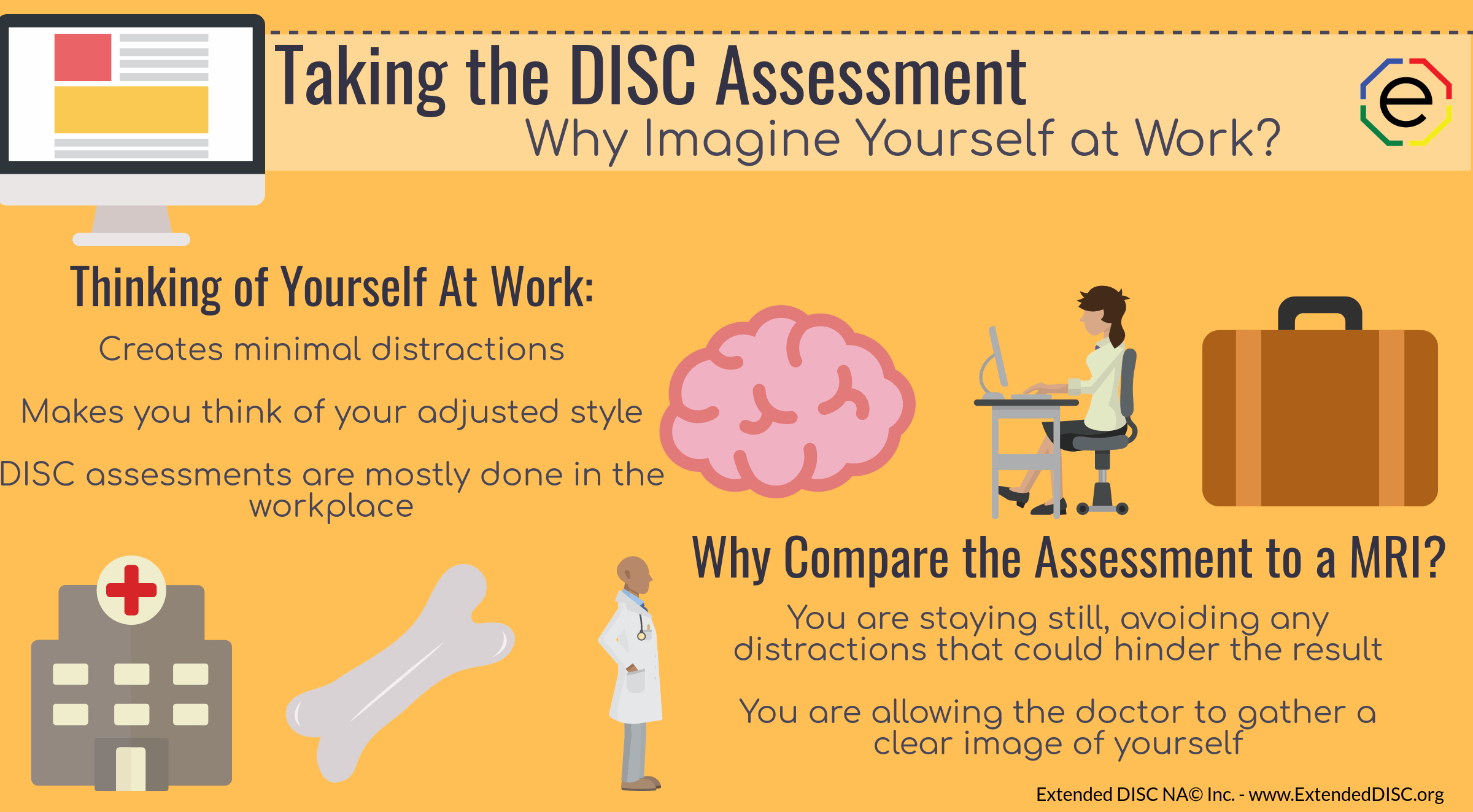
Think of yourself when you go to the doctor’s office and having a MRI scan. Your MRI scan creates images of the human body that a doctor can use for diagnoses. So when you are having the MRI scan done, you are directed to hold very still. Your stillness allows the MRI machine to get the clearest image for your doctor to use. The same concept applies to DISC assessments. You can avoid distractions by not multi-tasking when answering the brief set of DISC questions. You can then focus on the questions and answer as honestly and re-actively as possible. If you are able to eliminate as many distractions as possible and follow the simple instructions, you are likely to get clearer DISC profile results.
Other Reasons for Imagining Ourselves in our Work Environment
Creating a setting with minimal distractions is one way to get the best DISC profile results. Another reason for focusing on your work setting is to see how you feel you need to adjust your style in the current environment. We tend not to show our true selves at work because we need to conform to the work environment. You’re more likely to make adjustments in your work setting. On the other hand, you’re less likely to do the same in your more familiar home setting. The contrast between settings forces you to think and analyze yourself more. The same theory would hold true for the student who has the school setting and the home setting. Therefore, the system can better establish your answering pattern.
In the end, regardless of what setting or settings you imagine yourself in; our DISC assessments focus primarily on your stable and natural behavioral style. Your natural hard-wired style is simply how you prefer to do things and largely independent of your environment.
DISC Profiles: Food for Thought!
Recently, I traveled to Singapore to conduct a two-day DISC certification. I love doing DISC trainings and talking about DISC profiles, but add travel and food to the agenda and I’m in total heaven!
You’re wondering…”how do DISC profiles and eating in Singapore relate?” Bear with me. I’m always looking for the best places to get a great meal. Hawker centers in Singapore are semi-enclosed buildings that house an overwhelming array of food stalls. They are loud and crowded, but the food is cheap and sometimes amazing. So, in the potentially hundreds of food stalls, how do you pick the one to eat at? My free tip is to look for the food stalls with a line. The longer the line the better the food. Singaporeans know their food.
Hawker Chen’s Hong Kong Soya Sauce Chicken Rice and Noodle in Chinatown was one of the first and best I tried. His food stand was already on my radar because it was one of first ever hawker stalls awarded a prestigious Michelin Star. The Michelin Guide is an annually published guide to the best restaurants in the world. However, the ratings are normally given to fancy and expensive gourmet restaurants; definitely never before to food stalls!
The line was long, but for a plate of delicious soy sauce chicken and rice, costing only $1.50 U.S, it’s totally worth it. I ate a memorable meal for next to nothing, and I got to people watch and chat with others in line. I had also noticed Hawker Chen’s cashier was working in D-style mode. She had a no-nonsense approach that was definitely task-oriented, fast-paced, and perfect for the job. Do not even try to chit chat with her or waste her time!
Hawker Center Dining for Reserved DISC Styles
Even during my food extravaganza, there were things that still stood out to me from a DISC perspective. Sorry, I’m a DISC trainer so I can’t help myself. First off, if you’re a more reserved DISC profile, then you may want to avoid the crowded communal dining. If you can’t because you really want to try the food, there’s actually an area for you to eat in solitude. You can go at off-peak times or find yourself a small table facing a wall, and you’re good to go!
You can also plan ahead by searching the internet for the best hawker stands before you travel. As a foodie traveler, you could map out all your food destinations and have a clear, thought out itinerary of where to go and what to expect.

Hawker Centers for Active and Adventurous DISC Styles
If you love social interactions and taking risks in your food adventures, then this is the place for you. Communal tables and long lines allow you the opportunity to mingle with locals and travelers alike. Are you someone who loves making a definitive choice from endless options? Are you adventurous enough to try something new? Try the local favorites like Peranakan laksa or bah-kut-teh. Maybe you’re an extreme risk taker and looking for the one food stall no one else has the guts to try. Do you want to take on the challenge to eat at each and every food stall in a hawker center? It’s a overwhelming challenge, but come and try!
Once you’ve gotten your food, try finding a communal table and sit down. If you’re looking to chat, then Singapore is a great place for it as everyone speaks English! Ask what they’re eating or ask for suggestions on other hawker centers for your next meal. You can even use your DISC profiles identifying skills to scout out others who are more likely to be social and chatty.

Food and Culture for all DISC Profiles
So, whether it’s Singapore or any other country or region, take the time to try the local food. You can research ahead of time what kinds of foods sound interesting and worthy of your time. If mingling is not within your comfort zone, then order takeout or find a secluded spot. You can always go with family and friends to make the experience more fun and meaningful!
If you love trying new things hawker centers offer up so many choices. Take a risk! If you can, join a communal table and experience more of the food and culture.
The key to being a foodie and a traveler is to learn there are all kinds of opportunities regardless of a person’s DISC profile!
DISC Communication Beyond Face-to-Face
People may assume DISC only applies to face-to-face interactions. However, that would exclude using DISC in written communications and phone interactions. Luckily, it’s not true! DISC communication goes beyond face-to-face interaction.
Mastering DISC communication starts with a few basic steps. The key to DISC self-awareness and identifying DISC styles of others is to practice. Once you start using DISC to improve how you communicate, you can apply it to all of your interactions including face-to-face, emails, phone calls, etc.
Identifying DISC Profiles in Written Communication
We all need to know basic email writing skills, but DISC can take us one step further. In written communication, the tone comes from what the recipient reads into the words and sentences you use. In the business environment, adjusting the tone of the email is especially important since it can make the difference between a successful business outcome or not. First, if you don’t know the other person, you need to identify their DISC style through their writing. Once you do, you can make appropriate adjustments to your own writing style to create a more engaging and successful exchange.
Identifying DISC Communication Styles in Emails: D Profile
D-style emails are typically blunt and brief since they prefer moving quickly and getting tasks done. Details will be minimal and focused. You might even find the message content is fully contained in the subject line. Email greetings may start with “All,” or no greeting at all. Also, emails may lack punctuation, capitalization, or correct grammar. D-styles use command sentences telling you to do something over asking you to do something.
D-styles and C-styles will prefer a task-oriented written communication style. However, the D-style will prefer to focus on key, targeted information. In other words, brief, executive summaries and bulleted highlights work best. They also prefer an action-oriented tone which can produce results. Hence, focus on emails with a call to action or with next steps that allow them to control what comes next. In summary, keep it simple, stick to the task, let them decide whenever possible, and you will use written communication to your advantage with the D-style.
Identifying DISC Communication Styles in Emails: I Profile

I-styles may get your email and see it as a chance to call you to chat. Greetings often end with an exclamation point, “Hi! I just got your email!” If the I-style does email back, it is often one long run on sentence and jumping from subject to subject. Emails tend to be colorful and conversational to an extreme. They come across as optimistic, breezy and focused on people and emotions. The email may lack data and hard facts. In addition, punctuation and details tend to get overlooked.
When emailing an I-style, try to focus more on the person and feelings. Focus more on the positive and avoid unpleasant subjects. Avoid the overuse of data and details. Also, consider picking up the phone instead of sending an email whenever possible, especially if they don’t respond in a timely manner. The I-style may lose track of following up. More importantly, they will see it as an opportunity to talk and socialize! In the end, you are more likely to get the results you are looking for.
Identifying DISC Communication Styles in Emails: S Profile
S-styles are amiable, but more reserved than the I-styles. Their written communication is often understated, but friendly. Emails may start with “I hope this finds you well” or similar. The emails are fairly long in order to convey the message clearly and completely. S-styles may end with “sincerely”, “all the best”, “best wishes” or whatever is widely used in the field/industry. They may pepper the email with lots of questions and inquire about details. They tend to use the pronouns “we” or “us” over “I” and “me”. S-styles prefer to focus on cooperation, so they will tend to use sentences asking you to do something over telling you to do something.
S-styles need to have enough information to make the best decision for themselves and the people around them. Answer their questions carefully and progress step-by-step. Focus on the specific benefits of making changes and how it impacts them. Provide reassurance whenever possible. Use plural form when addressing them, “you and your team”. Do not pressure them into making decisions with hard deadlines they have not previously agreed to. Also, be sincere and if possible, build trust and a relationship. Follow up and do what you say you are going to do.
Identifying DISC Communication Styles in Emails: C Profile

C-style written communication may be so long you will have to scroll down to find the end. The emails will have a lot of detail and facts. The tone will be more formal, fairly cool, less personal, and somewhat complex. You probably will note it has been spell checked and free of grammatical errors. In areas they are knowledgeable, they may come across as nit picky or critical. They will ask a lot of detailed questions and may not express opinions or focus on the big picture. Often times they will not be able to progress further until they have all the information they need.
Overall, C-styles are naturally more reserved and therefore, prefer written over face-to-face communication. C-styles, like D-styles, prefer a task-oriented writing style, but C-styles want detailed information. They want the details and facts, which will allow them to respond correctly or make the correct decision. The emails should be written succinctly and clearly. Whenever possible, the emails should preemptively answer any questions a reader might have. For example, a frequently asked questions section about the content can help clarify the information. Lastly, make sure to proofread and fact-check!
DISC Communication Styles Via the Phone
Identifying DISC styles via the phone is part science, part art, and all practice. You and the person you’re calling will form opinions based primarily on the words used, like in a greeting, and the tone of voice. You can do it quickly with practice. Just like written communication skills, effective phone skills can also be enhanced by understanding DISC. We are often told to be friendly, listen actively, and be courteous, but that may not be enough. We are assuming that the person on the other end of the phone wants the same thing. There are basic tips for better telephone meetings, but identifying DISC styles in others can give you a competitive edge.
DISC Communication Styles Via the Phone: D-styles

For the D-style, you might hear the greeting, “you know what to do!” and boom! You immediately need to leave your message. Voicemails from D-styles are usually very short, action oriented, and to the point. They will speak quickly and assertively, “This is John. Call me”.
If the person on the phone speaks assertively and quickly then you’re likely speaking to a D-style. Remember to get to the point, avoid details, and state the specific purpose of the phone call. Don’t over personalize the call and become too chatty. Recognize that they may be multi-tasking so get your point across quickly. You may not be used to the overbearing, aggressive and blunt tone, but stay focused on tasks and results. Ultimatums and lack of control in the conversation may quickly end the phone call and your chance for a successful call.
DISC Communication Styles Via the Phone: I-styles
You might hear I-style’s greeting as, “So sorry, you missed me! Have a great day! Cheers!!” When leaving messages, the I-styles are often cheery, funny, and animated. The phone messages may be fairly long and run on at a rapid tempo. You may end up not being clear what the reason for the call was. Messages may include phrases “well, anyway…” or similar. They may forget details like leaving a call back number.
Be prepared to add extra time to chat on a phone call with an I-style. For I-styles, it’s best to let them speak and listen more and enthusiastically when possible. Be friendly! When speaking, avoid too many details and focus on the positive effects of the interaction.
DISC Communication Styles Via the Phone: S-styles

A sample S-style greeting may say, “I am so sorry I missed your call. However. I do check my messages regularly and I will return your call as soon as possible. If you need assistance now, please hit “0” and my associate will gladly help you. Or, you can call me on my cell phone. Again, sorry to miss your call”. Voicemails from the S-styles are typically amiable, lengthier, and slower tempo. You may hear the phrase, “sorry to bother you” and hear the message conclude with, “I look forward to your call. Thank you”.
S-styles need enough time to process information before making decisions. Initially, you may be doing more of the talking while they are actively listening. Build trust and rapport. Be sure that they have been able to think through a thorough response—and have time to respond. The response may be simply to let you know they heard what you said and not necessarily an agreement of your question or proposal. You need to provide context and rationale and it’s best to bring them up to speed on the who, what, where, when, and why up front. Try ending the call with a date for a follow up call.
DISC Communication Styles Via the Phone: C-styles
The common C-style greeting may be, “You have reached my voicemail. Please speak slowly and clearly. Leave your number, the time you called and the reason for your call. Please leave a good time to call you back”. The C-style will be more formal. They will speak in a softer and even keeled voice with a slower tempo. Often, phone messages will include lots of detail about the reason for the call. Also, they may their leave call back number twice. They may even follow up with a detailed email to make sure you have all the information.
If you have a phone conversation with a C-style, then you may be doing more of the talking. Make sure to answer questions slowly and with details. Periodically, check for understanding. If possible, send them an email prior to the phone call to let them know the context of the call. The more information the better. Do not pressure for an immediate decision. You may need to make multiple calls or follow up with additional information via email.
Additional Tips for DISC Communication Beyond Face-to-Face

There is no one-way of successfully communicating with another person. However, any additional information you can acquire about the person, can help improve your interaction. In addition, it can save you frustration, time, and energy on both sides.
As with any mastery of DISC, you need to practice. Adjusting styles when writing emails and making phone calls appears to be extra work, but the payoff may actually end up with less work on your part. But, with the number of phone calls and emails we all get every day, people really will notice the difference when a good email or engaging phone call comes through. Your mastery of DISC could be the difference between getting overlooked and getting what you want.
Tip: Practice creating email templates based on each of the DISC styles.
Bonus tip: If you have a customer relationship management program (CRM) consider adding a field for your client’s DISC style. That way, you and your co-workers will have valuable shared information to create more impactful interactions.
Finding DISC Test Resistance? Get Everyone Onboard
Use of the DISC test in your workplace can lead to better understanding and interactions within your team. However, you may encounter resistance and misunderstanding during the process.
Just hearing the term “test” in the DISC test can create anxiety and resistance in different people. Your team is made up of a diverse group of personalities. Each of your employees have their own way of thinking and working, but they all have one thing in common. Like most of us, they don’t like change or even the potential for change; there are entire books written about how small changes can create discomfort and chaos in the workplace. Understanding why people fear and resist even small changes or new things can help you successfully integrate something new into your workplace routine.
When you decide to employ a DISC Style assessment to help better understand and manage your workforce, you may encounter some resistance from surprising places. People may resist trying something new. They may fear the unknown or it may stem from a lack of understanding. However, you can help overcome resistance by introducing the DISC test in the right way. Once your team understands how their DISC test can help them in the long run, they’ll be far more willing to play along. Some, including your High D types, will happily anticipate what they may see as a competitive opportunity to showcase their skills, even if results are just between the employee and HR.
Why We Resist New Things at Work

A DISC assessment is not a huge change, but it does imply that changes could be coming, depending on results. That distinction is enough to cause some of your team members undue stress. When something new is on the horizon, we resist for a few basic reasons, according to INC magazine:
People can fear the unknown. You don’t know what the new thing is or what it does, therefore you resist it.
Fear of failure: This new thing may require skills you do not have or that you won’t perform well on it, therefore, it should be resisted.
Disruption of routine: You get used to habits, and something new can disrupt the stability and foundation of your day.
Worries about the future: How will this new thing change my role, the workplace culture or my routine? What happens when the results come in? Who will see this, and will it impact my chances of advancement?
Providing your team with information on what the DISC test is, why you are using it and that your end goal is to make the workplace a better place to be can help allay many of these typical fears.
Ways to Combat DISC Testing Resistance
Often employees simply fear change or trying new things. Sometimes they don’t have enough information. Fully explaining what DISC assessments are, how they can benefit the workers who take it and most importantly, how you will use the DISC test results to make your workplace better for everyone can help make the test more acceptable. These tips will help reduce any lingering resistance and ensure your team is on board for your scheduled assessments.
Present It as a Gift
It works with pets and babies – and adults, too. Pushing something new, from a new leash to a new potty chair, can cause a puppy or toddler to resist. Offer that same item as a gift to be enjoyed and they may embrace it. Of course, your team is far more sophisticated than babies and pets. However, presenting the DISC assessment and its benefits can help bust any resistance.
With the DISC test, you’re offering your team access to deep insights that can help them move forward. Each team member will gain insights from the individual DISC report. The information can help with communication across the board, at work, at home, and socially. Pure curiosity can win out as well. Try having some of your more garrulous employees go first and watch them spread the word. The resulting conversations will pique the curiosity of the rest of the group and make them more willing to sign up for the assessment.
Reward Early Adopters

Make sure you have something special waiting for your participants. Consider giving a special perk or a nice breakfast treat to those who volunteer to go first. If you’re giving out free coffee and carbs, the word will spread fast and you’ll have a line waiting before you know it.
You may want to offer a perk to the first group to complete the assessment. It can be an effective way to kick start the DISC test process. Rewards can be simple and small, but still of value to the participants. Since there are no “right” answers or ways to win, the best way to get the desirable reward will be to sign up for the assessment in the early stages.
Make Sure Your Team Knows What DISC Is
Presenting information on the DISC model, the assessment, the different personality types and how it works in advance can help defeat resistance. You can point out that there are no right answers or “best” types and the DISC test cannot be “failed”!
For those who are not good with technology, focusing on the easy to take aspect and highlighting the fact that no special skills are required can ease any fears or concerns they may have. Your young, digital natives will have no issues, but some senior team members may not feel confident enough in their own skill sets to face what they could see as a technological challenge.
Recruit the Influencers First
Managers, team leaders and key influencers will have a big impact on how the rest of your team feels about the assessment. When these leaders, well liked individuals and trend setters are onboard, many of your team members will follow along. The DISC test will be seen as having built in approval from your team influencers . Get some of your sociable extroverts to take the DISC test first. Their natural talkative nature will help spread the word that there is no cause for concern.
Reveal Your Reason for Testing
Let your team know why you are offering the DISC test. Are you finding new ways to support your team, or looking for better ways for them to collaborate, etc.? Once your team realizes that the whole reason for testing is to come up with a better culture for everyone, they’ll be more likely to get onboard.
Be Proactive When Using the DISC Test

Most of your team member’s resistance often occurs in the preliminary stages. Once your team sees how easy the assessment is to complete and how useful it actually is, you should encounter little to no resistance. When the results roll in, you may encounter similar resistance. Focus on helping your team work though results that might be surprising or needs further discussion.
The resistance we see to the idea of taking the DISC test is usually based on fear; once you fill in the blanks on the unknowns, let your team know just how simple the test is and highlight the beneficial end results, you should not have any problem getting everyone onboard.
Ready to access new insights and take your workplace culture to a whole new level? DISC testing can help you get the information you need to help your team grow and succeed. Contact us to learn how easy it is to get started and to find out just how much a DISC assessment could help your workplace thrive.
Does DISC Apply Across Cultures?
As a DISC trainer, I’ve been asked if DISC applies across different cultures. If so, how does it correlate to culture?
There is a link between DISC and cultures, but it may not be as clear as we think. Does where you live or your cultural background influence your DISC profile? Are the behaviors that we observe in all D-styles similar and recognizable? Is there any difference between a D-style in Singapore versus a D-style in the U.S.? Let’s start from the beginning with the DISC theory.
How the DISC Theory and DISC Assessments Works

DISC measures your most comfortable behaviors or how you naturally prefer to do things. The DISC theory itself does not judge behaviors as right or wrong or good or bad. There are no styles that are better or worse. Each of the four DISC styles simply has similarities and differences.
In order to create a persons’ DISC profile, we start by collecting data from his/her DISC assessment. The process of collecting data is purely based on statistics and thus, culture-free. How many times does the person select answers based on one DISC style over the other DISC styles? If there is a clear pattern of response that aligns with at least one DISC style, then a valid DISC profile is generated. An invalid result indicates the person was not able to answer in a clear enough pattern to identify at least one DISC style.
The key to valid DISC profile results is to find key words that cause the preferred style of person to respond in a desired way. The intent of the questionnaire is to find out how the person compares to other people within the same culture. Translating the questionnaire is therefore the key issue; it cannot be a direct translation of the language. In order to support the findings, a validation study is needed to check if the tool can really identify the different behavioral traits with a culture. That’s why we recommend that our clients take the DISC questionnaire in their most comfortable native language, even if they are multi-lingual. Regardless of the language clients use to answer, the results will always default into your preferred language. For example, if your client chooses to answer in Mandarin Chinese, you can still receive the results in English.
What is the Correlation between DISC and Cultures?
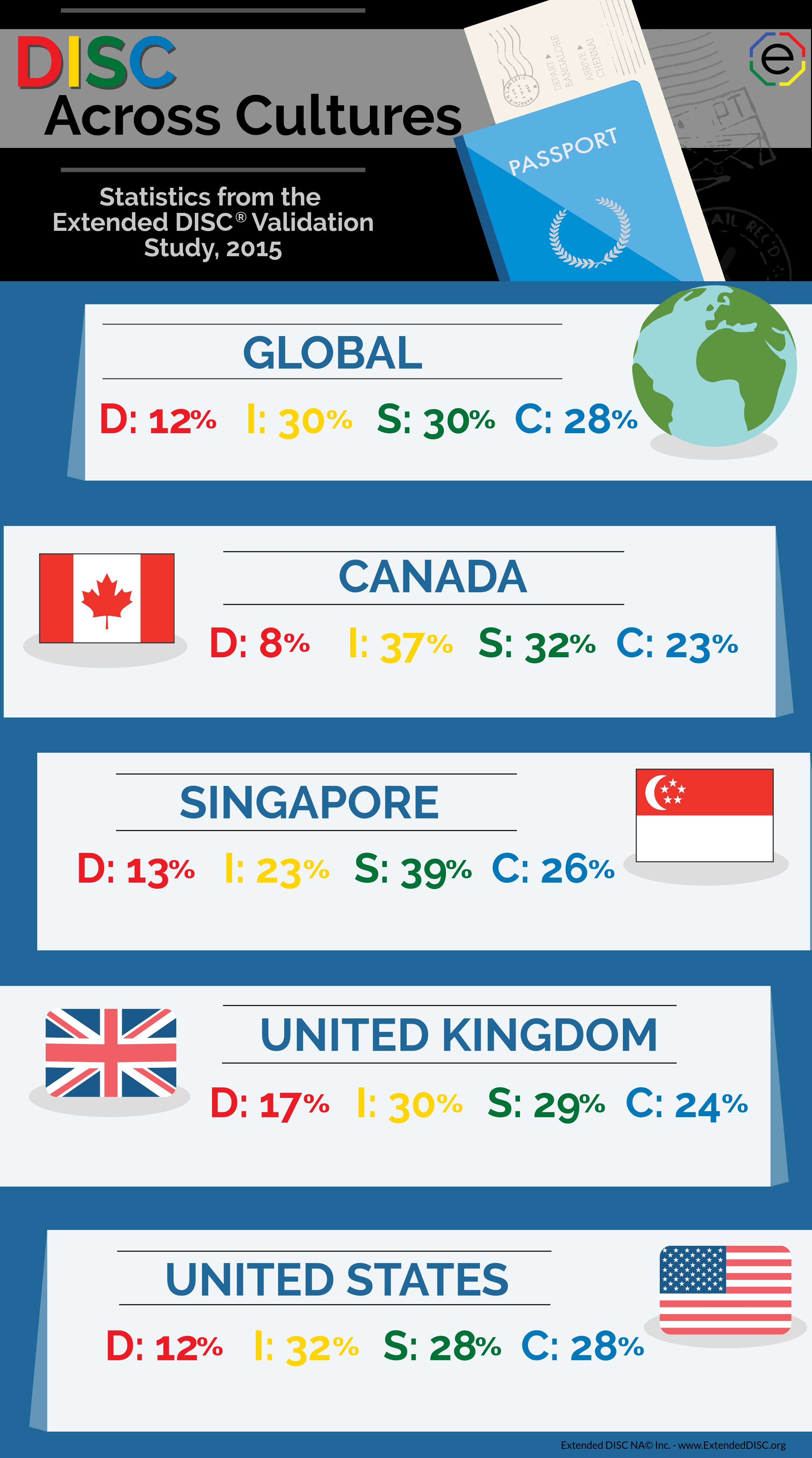
Once the data is collected and the DISC profile is generated, it can be applied to specific styles and settings. The style areas may include communication, leadership, and decision-making. To be able to interpret the data, you need to have an understanding of DISC; especially the context where the information is applied. This part is culture bound and thus, requires an understanding of the culture.
In other words, you don’t need to know exactly how the data is produced, but you need to understand the tool is based on DISC. You do need to understand the environment where the results are being applied. If someone is identified as a D profile, it means that when he/she took the DISC questionnaire, the person prefers the D-style responses. But, what does it mean in Singapore for example? This is something the DISC tool cannot determine. The DISC results only indicate that compared to the other Singaporeans, this person is more D-style. It is then up to those who understand the culture of Singapore to determine what exactly D-style means and how D-style behaviors are identified.
Your Remote Team and DISC Assessments
Allowing the right team members to work remotely from home has some well documented benefits. In fact, using a remote team can lead to lower overall costs and increased productivity.

A manager needs to choose the best remote team members for the required work and support them properly. What makes someone an ideal candidate for working from home or a satellite location? What support do they need and how can you set them up for success? A look at the actual individuals and their working styles and personalities reveals a lot about what makes them tick and how to set them up for success.
How DISC assessments can reward your remote team and help them succeed
If you are familiar with DISC assessments for your in-house team, then you already know how helpful it is to be able to reward and encourage individuals in the right way. But, is that important for a remote team since you don’t see them as often? Knowing the key personality traits of your remote workers is essential if you want to set them up for success and reap the rewards of a remote team.
To perform their jobs effectively and truly feel part of the team, your remote workforce needs a variety of support, equipment and essentials. Here’s what you need to provide each team member if you want them to work remotely.
Technology and your remote team
Your remote team needs tech and equipment that is at least as good as your in-house workers. From laptops to printers, your remote workers need to be able to have technology at their fingertips to make things work. According to Business News Daily, the technology you provide plays a big role in not only how well your team can perform, but also how motivated they are to succeed at remote work.
Giving them the latest laptops, tablets and phones ensures they’ll be able to connect with ease. Equipping them with out-dated tech tells them you do not really value their contributions. If you provide your remote team with slow Wi-Fi, leftover laptops, and an old printer, you’re setting them up for failure. Instead, if you can position remote teams for success by providing the latest tools to connect with the team (including you). They will therefore, feel just as valued as in-house staff. In short, treat them like the valued professionals they are and you’ll get the best ROI from the experience.
Connectivity: next step from technology
Your remote worker often requires more than just a good printer and laptop. They may need better audio and video equipment, too. Consider tools and equipment they need to video chat, join meetings on a remote basis and interact with your team. This ensures they can truly communicate with everyone at your office and that they feel like they are an essential part of your team. A remote worker may need a video camera, microphone, and speaker setup. There may even be times a second laptop or device would help to share documents and files while chatting.
Accessibility for your remote team
Your team needs to be able to safely and securely access your network and files. Your IT department can help set things up. Ideally, remote workers should have the same access and collaborative abilities as those doing a similar job in-house. The more data you have in the cloud and the more tech friendly your workflow is, the easier it will be to incorporate remote workers.
Communication is key
Your remote workers need to feel like they are part of your team, not an afterthought. Including them in brainstorming sessions (via the aforementioned tech), meetings and even casual water cooler chatter can help them feel like they are an essential part of your team. How frequently you communicate, the methods you use and even your overall approach will depend largely on each individual’s personality and style.
Compatibility

Choosing the right team to work remotely, and offering them support that best suits their DISC assessment results, helps position your brand for success. Having the right team members in place, who can work at home, helps your organization reap the rewards. You will most likely build an efficient and motivated work force.
Is DISC Important for Remote Team Members?
DISC assessments can help you effectively manage all teams, but they are particularly useful when you are setting up remote work teams. DISC assessments can reveal each candidate’s preferred and natural working and communication style. Once you know if a particular team member is more project driven or people driven, you have some key insights into the actual type of support they will need and into the challenges that could deter them from successfully working from a remote location.
How to Use the DISC Test for your Remote Team
Offering DISC assessments to your team allows you to uncover their innate preferences and styles. While there is no one DISC type that is best for remote work, identifying your employees DISC style will help you choose the right mix of candidates and offer them the right mix of support.
Using DISC to Power and Support your Remote Team

Knowing your team’s DISC assessments results is always beneficial, since you can tailor everything from assignments to workstations to match your worker’s skill sets and preferences. For remote workers, the knowledge imparted by a DISC assessment is even more meaningful. You’ll know how much support, attention and feedback each member will need, and even get a good idea of which of your team members can handle the sometimes-isolating aspects of remote work. Since each individual style needs different support and will value difference aspects of remote work, knowing what to offer is essential if you want to have a successful remote program.
Knowing Your D-Style Remote Workers
Driven D-style workers will stay on task, deliver completed projects and get things done. Completion of tasks will not be much of a challenge. However, they could suffer from lack of connection. The D style worker thrives on competition and being heard. Try to ensure these team members can make their opinions heard. They will want to update everyone on their achievements and tasks. This will keep this remote working powerhouse motivated and productive.
Knowing Your I-Style Remote Workers
Your outgoing, interactive I style team members are going to need the most interaction and support. It won’t be just for the work itself, but I-styles need to feel like part of the team. A collaborative tool that always stays open, like a Slack channel, can help this worker feel involved. Just don’t be surprised at the amount of chatter that comes in over the line once you open it up.
Knowing Your S-Style Remote Workers
Their steady, calm and trustworthy attitude makes them ideally suited for remote work – but they could be resistant to change. If you are transitioning in-house workers out to your remote team, provide support to this group along. It’s kind of like moving a cat to a new home. They may be suspicious at first, but once they settle in, everything runs smoothly. The good news is, once they settle in, they will be your most reliable, go to team member. Also, provide as much information about the move as possible. Your S-style team members will respond better to the changes.
Knowing Your C-Style Remote Workers
These logical, analytical team members can also be effective remote workers. However, don’t be surprised if they shy away from the video and Slack channels you’ve chosen to support other styles. Written communication will trump interaction with others. Your C-style team member will need to know who to go to with issues, concerns and problems. They will expect detailed data-based answers on a regular basis.
Using a DISC approach ensures you get can better build and support your in-house and remote teams.
DISC Trainer Meets Lyft Driver: DISC Training 24/7
My job is being a DISC trainer, but sometimes I’m happy to be reminded how powerful DISC is to my own daily interactions.
One of the perks of being a DISC trainer is getting to meet new people. Sometimes, I even get to travel and meet new people. Here, I was on the road in Indiana.
DISC Trainer Meets Lyft
While I’m not the worst, I do find myself technically challenged at times. However, it’s all relative, right? I think I compare well against my age group, despite what my kids tell me. I’m at the airport and it’s late in the evening. I’m reminded of how late it is because there’s more airport staff than there are airport passengers. I pull up my Lyft app on my phone. For those of you who are even less savvy than me, the Lyft app is a way to call a driver to pick you up and take you to your destination. Five minutes later, my Lyft driver pulls up in a black Chevy Nova. How do I know? My handy app shows me a picture of my driver and the car he’s driving. Pretty cool right? I get in the car.
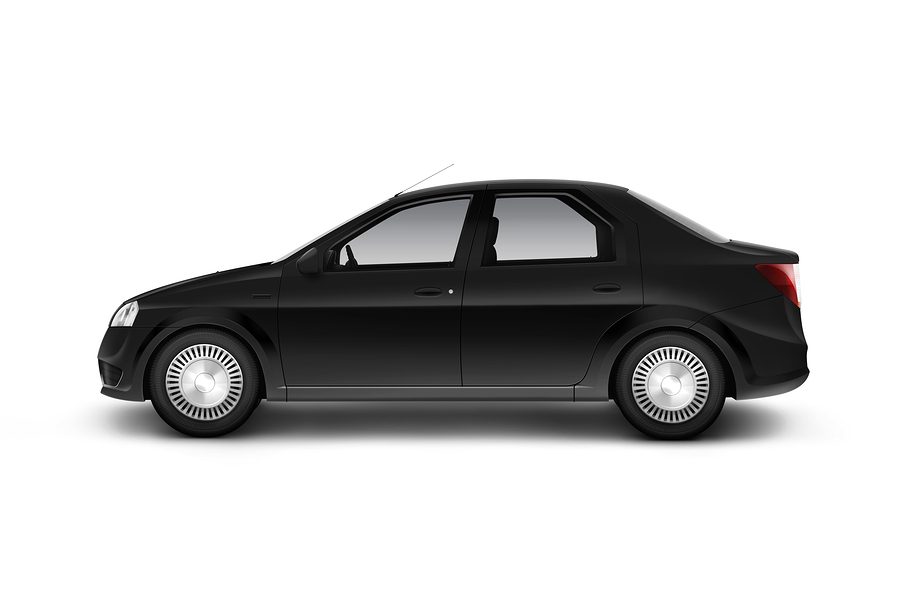
DISC Training on the Fly
Another great feature is the ride has already been paid and the destination has been set which means there’s nothing left to do but to quietly enjoy the ride or chat. My Driver, Sherman, immediately started up a conversation the moment I got in and closed the car door. The radio was blaring ‘Uptown Funk’ by Bruno Mars. Hey, I’m current on my music! I noted he didn’t feel the need to turn down the volume when talking. Rather, he just spoke louder over it. He had one hand on the wheel and the other waving around the air as he spoke. I had already made these observations, but I wasn’t consciously aware I had until he asked me to identify his DISC style.
Sherman asks what I’m doing in Ft. Wayne, Indiana. I told him I’m in town to do a training. He asked the type of training I do. I tell him it’s a masters training for coaching and using our behavioral assessments. He surprises me by saying, “like those letters B, E, something?” While he didn’t get the DISC letters right, he was on the right track. That’s when he asked if I could tell him what his DISC style was.
Observing DISC Styles of Others
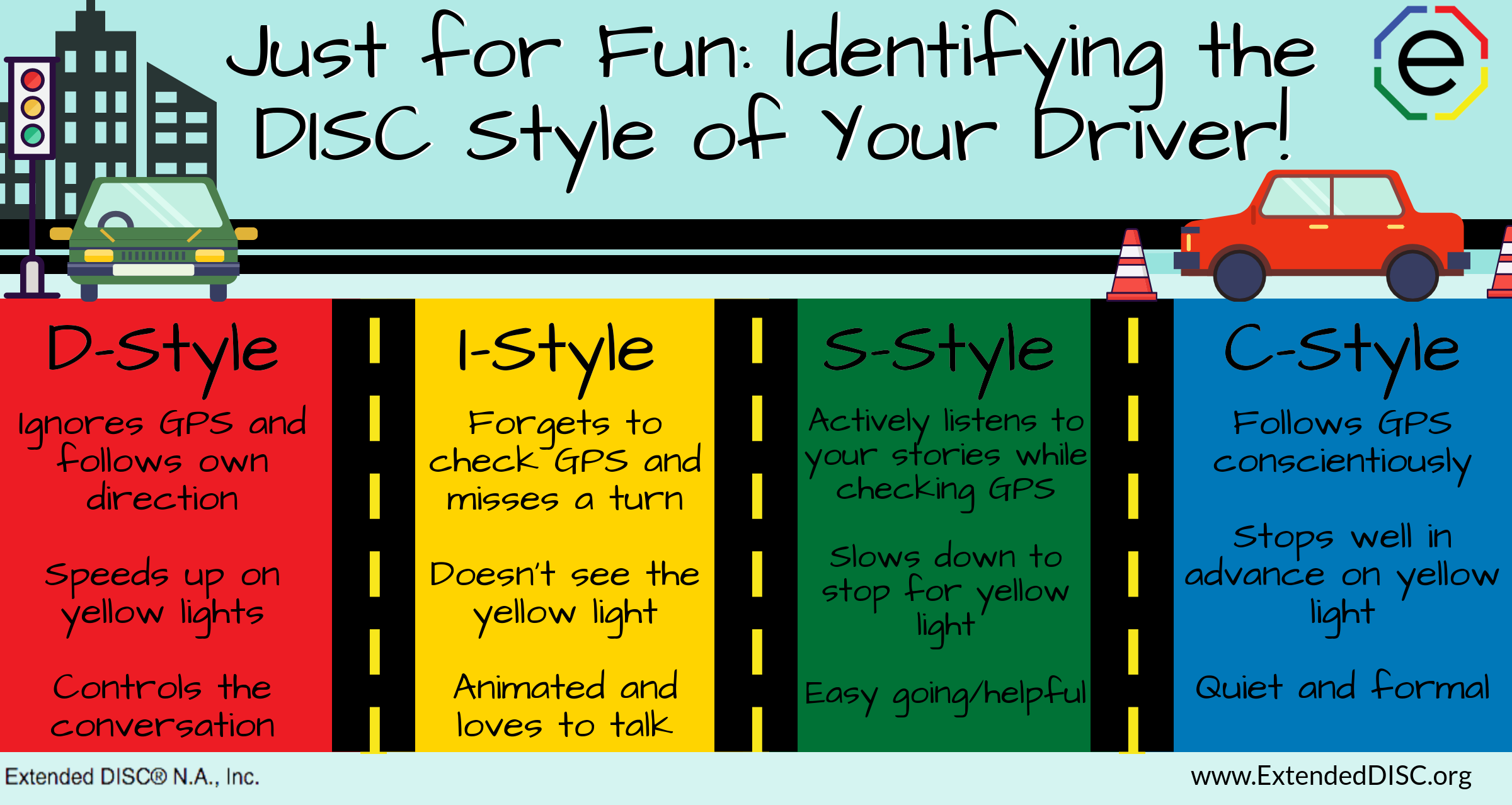
Time to put my money where my mouth is. So, in the brief moment I had observed him, I identified him as being on the Active side of the DISC Model. In real time it would seem awkward to have a long period of silence in our conversation for me to process. I just went for it by saying, “you’re likely a D-style or I-style.” People who are on the active Active side of the DISC model are more likely to NOT be quiet, and tend to be more assertive and animated in their body language. They are also more likely to talk over listen, especially the I-style.
Note to Self as a DISC Trainer
After describing the DISC profiles, I asked him how accurate he thought I was. Immediately, he agreed with me. I was feeling good. We talked some more about how Ft. Wayne was a great place to raise kids. Also, in light of the many recent natural disasters, it was a safer place. Hurricanes, earthquakes, and other natural disasters were pretty much unheard of in Ft. Wayne. As someone coming from Houston, Texas, Ft. Wayne sounded wonderful right about then. The time flies by and twenty minutes later we arrive at the hotel.
Identifying DISC styles of others is part science, part art, and all practice. You may constantly need to make adjustments as you observe and gather more information about the other person. However, the more information you have about the other person, the better you can interact with them. Ultimately, it felt good to spontaneously teach a complete stranger about DISC in a 20 minute car ride. Hey, it’s not just my job, it’s what I do!
5 Ways to Boost Employee Morale
Losing employees is expensive, but it also causes disruption and can lower morale for your remaining employees.
 The more you do to improve your workplace morale and keep your team positive and satisfied, the less likely you are to experience a lot of turnover or churn from your best talent.
The more you do to improve your workplace morale and keep your team positive and satisfied, the less likely you are to experience a lot of turnover or churn from your best talent.
How DISC Helps Boost Morale
In many ways, simply treating your team well, investing your time and truly caring about their life milestones, achievements and goals goes a long way. A personal connection is enough for some of your employees. For example, workers with the “I” or “S” DISC styles in particular, will respond well to this approach. For your more task driven hard “D” and “C” types, loyalty can be cemented with tangible rewards for diligent work and tasks well done.
Any time you spend recognizing your teams and individual employees for their achievements and contributions, you’re doing far more than handing over a piece of paper or a gift card; you’re incentivizing and motivating them to continue performing well. Satisfied, happy, loyal employees will keep your business chugging along at top speed and ensure that you are able to meet your goals as a company, according to the Society for Human Resource Management. High morale also makes the workplace just a more positive, better place to spend your time, so everyone wins when your team has an amazing workplace culture to enjoy.
Assess Your Team’s Morale
Is your team excited to arrive and ready to tackle new things? Do you hear laughter, joking and enjoyment – or is there a steady stream of negativity and resentment? If you are losing team members, seem to have a negative or unmotivated team or a lackluster culture; one or more of these tips can help. Doing great? Incorporate these tips to improve your workplace even more and retain your top talent. Here are 5 tips to help boost your team’s morale.
Tip #1: Show That You Care
Show that you care: You need to demonstrate that you care about more than just what your team does on the job. A simple “Happy Birthday”, a gift for a new arrival or even a “congratulations” when a child’s team wins a big game goes a long way towards connecting with your team. The more people-oriented team members (DISC styles I and S) will particularly appreciate this approach and respond to it well.
Tip #2: Recognize Accomplishments
 Recognize accomplishments. It may be easy to recognize and reward that one high D saleswoman. However, you need to consider the support team that made sure your company’s biggest order ever was delivered on time and in perfect condition. Make sure that your employees feel valued and that their contributions are noted. Highlight this team in the company newsletter. Take everyone out for coffee (or order in). Send a note of thanks to keep everyone happy. These are simple, but effective ways to promote morale.
Recognize accomplishments. It may be easy to recognize and reward that one high D saleswoman. However, you need to consider the support team that made sure your company’s biggest order ever was delivered on time and in perfect condition. Make sure that your employees feel valued and that their contributions are noted. Highlight this team in the company newsletter. Take everyone out for coffee (or order in). Send a note of thanks to keep everyone happy. These are simple, but effective ways to promote morale.
Tip #3: Be Surprising!
Be surprising! Is your company still giving out the same plaque, at the same party, with the same cake every year? The magic could be gone. You don’t have to wait for your annual awards to hand out thanks. Minor, yet unexpected surprises make a much larger impact. You may think about springing for a few gift cards. How about awarding your team with coveted electronics or even hoodies or gear with your logo. They will remember and respond.
Tip #4: Give the Gift of Time
Give the gift of time. Consider mental health days, sick days, vacation days, or whatever you want to call them. Try offering an added paid day off. It could be a big incentive if it’s a day that is not connected to a holiday. You can choose one day for a companywide mental break. You can also allow your team to choose a day of their own. Either way, you’ll get a positive response. You will have given them time to do something they love, without sacrificing some of their paycheck.
Tip #5: Mix in some friendly competition
Mix in some friendly competition: Head to an escape room (we did!), organize a volleyball tournament or just some silly games for a company adventure. You’ll all have fun and every member of your team will engage and bond. Your high D types will love the chance to show off and get competitive, while your more people-oriented workers will enjoy the chance to connect in a different way. The staff at FatWallet has video games scattered throughout the facility and regularly engages in fun but competitive tournaments during the work week to keep everyone involved and connected, according to the Rockford Register.
Get the Inside Scoop on What Motivates your Team
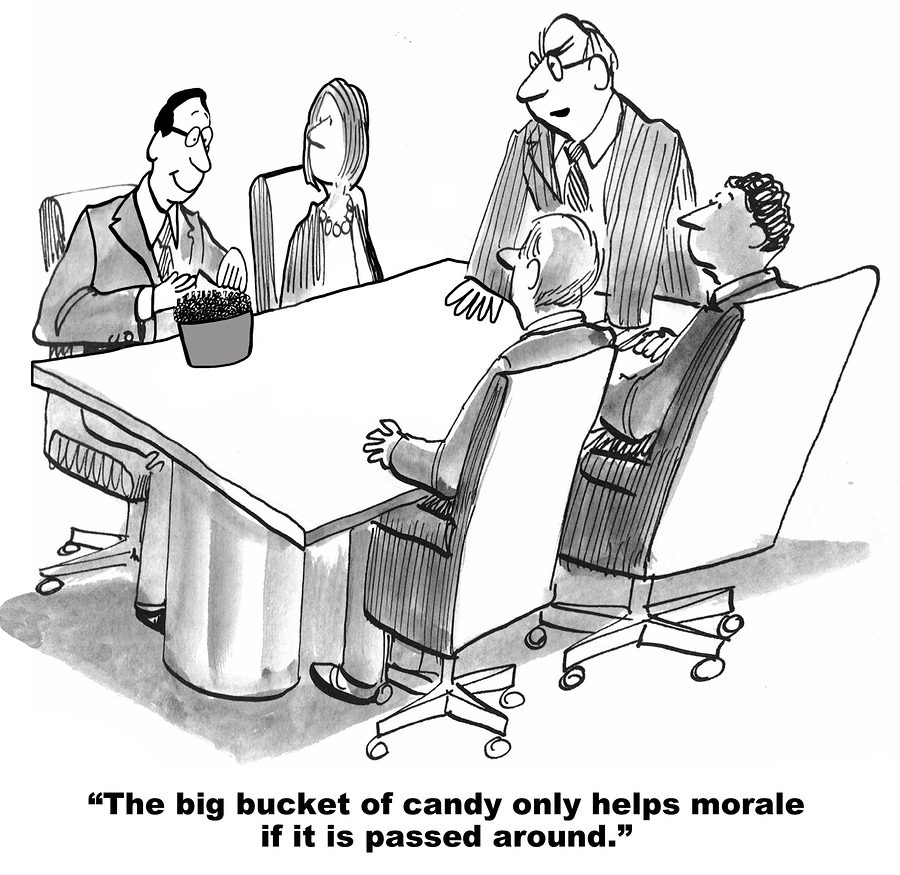 You can’t do it all at once, so what should you try first? A look at your team and their individual DISC assessment profiles can help you figure out if you need relaxing fun, indulgent food or some hard driving competition – or a little of each. Learning more about what motivates your team can help you determine which approaches are most rewarding and enjoyable for them; once you know, you can improve morale with ease. Need to know your team’s DISC profiles and styles? We make it easy! Contact us to learn more about DISC and how it can help you boost your team’s satisfaction and morale at work.
You can’t do it all at once, so what should you try first? A look at your team and their individual DISC assessment profiles can help you figure out if you need relaxing fun, indulgent food or some hard driving competition – or a little of each. Learning more about what motivates your team can help you determine which approaches are most rewarding and enjoyable for them; once you know, you can improve morale with ease. Need to know your team’s DISC profiles and styles? We make it easy! Contact us to learn more about DISC and how it can help you boost your team’s satisfaction and morale at work.
Identifying DISC Styles of Others
One of the strengths of the DISC Model is identifying DISC styles of others. Learn 3 simple steps to improve your observation skills.
You will need to practice identifying DISC styles of others, but it’s a skill that is easy to learn. In doing so, you can adjust your style appropriately to improve your interactions.
How Do I Start Identifying DISC Styles of Others?

We focus on a 4-step approach to improve our daily interactions. First, you’ll need to understand DISC; how we are similar and different. Next, you focus on self-awareness by knowing your own DISC style. We are focusing on the third step, which is identifying DISC styles of others. Ultimately, you want to modify your behaviors appropriately to improve interactions with others.
As you become more familiar with the DISC styles, you will find some people are easy to identify. You will quickly think to yourself, “she’s a D-style” or “he’s an S-style“. You can easily identify these people when they are primarily one style. The rest of the people you encounter may take a little more practice and effort.
Identifying DISC Styles of Others Using OAR

OAR is an acronym that stands for Observe, Assess, and, Recognize. It’s a simple 3-step process that you will learn quickly. Once you’ve practiced it, you will be able to easily include identifying DISC styles of others into your daily interactions. The skill is not limited to face-t0-face interactions. Consider using it when you are on the phone or corresponding via emails and texts. In addition, you may observe others over long or very brief periods of time.
Step 1: O Stands for Observing
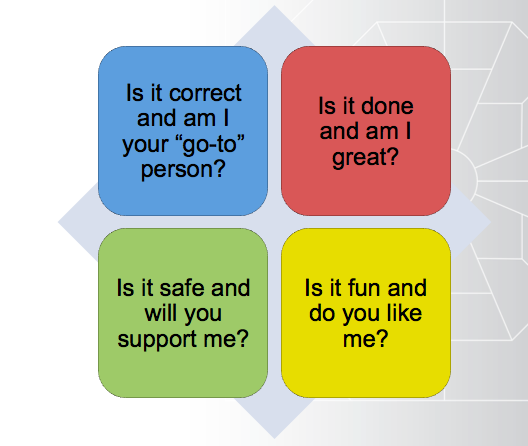 First step to identifying someone’s DISC style is to simply observe behaviors. What does the other person tend to talk about? S-styles prefer to focus on family and relationships. What if they tend to focus on hobbies, accomplishments, or name-dropping? Do they talk a lot or do they say nothing at all? Are their emails short or long and detailed? You’re looking for patterns in their behaviors.
First step to identifying someone’s DISC style is to simply observe behaviors. What does the other person tend to talk about? S-styles prefer to focus on family and relationships. What if they tend to focus on hobbies, accomplishments, or name-dropping? Do they talk a lot or do they say nothing at all? Are their emails short or long and detailed? You’re looking for patterns in their behaviors.
Next, consider how they tend to say things. What type of words do they use? For example, D-styles and I-styles are more individualistic and may tend to use the pronouns “I” and “me”. On the other hand, S-styles are considered to be team players of the DISC profiles. They may prefer to use plural pronouns like “we” and “us”. C-styles tend to be more economical in their choice of words; whereas the I-style loves using superlatives. For example, when a C-style tells you something is “good” or “fine” it really is a positive response. I-styles, on the other hand, are more like to respond and use words like “amazing!” and “fantastic!”
You should consider the types of questions people ask. D-styles tend to ask the what questions. For example, they may ask, “what’s the bottom line?” I-styles tend to ask the who questions. S-styles tend to ask the how questions and C-styles tend to ask the why questions. Also, when using sentences, do they tend to ask you to do something or do they tend to tell you to do something?
Listen to their tone of voice. Do they tend to talk in a louder voice or more quiet voice? When they speak do you hear a lot of inflection or are they more monotone? Do they speak with confidence? Are they more emotional?
Step 1: O Stands for Observing: Body Language
Body language is a highly useful way of identifying DISC styles. In addition, it can be a quick way in identifying DISC styles of others. Is the person’s body language animated? For example, do they talk using their hands or use a lot of facial expressions? Is their body language more still and closed?
Not only is it quick, but you may even be able to recognize someone’s DISC styles before the verbal exchange occurs. Let’s say you’re an I-style and about to meet a prospect. He’s walking towards you. You notice he’s not making eye contact and he appears hesitant. You’re likely thinking your prospect is going to be more reserved. Now is the time to remind your I-style self to approach slowly, tone down your voice, and don’t overwhelm. Observation is a critical skill. However, with practice, you will find more success in your interactions.
If you identify someone as people-oriented it does not mean you’ll never see S-styles and I-styles not do tasks. In reverse, task-oriented doesn’t mean D-styles and C-styles can’t or won’t interact well with others. It simply means these are their natural preferences and tend to be natural behaviors. The more you observe and assess the easier it becomes. Now that you’ve observed, you can move on to the next step; which is to assess.
Step 2: A Stands for Assessing: Reserved or Active?
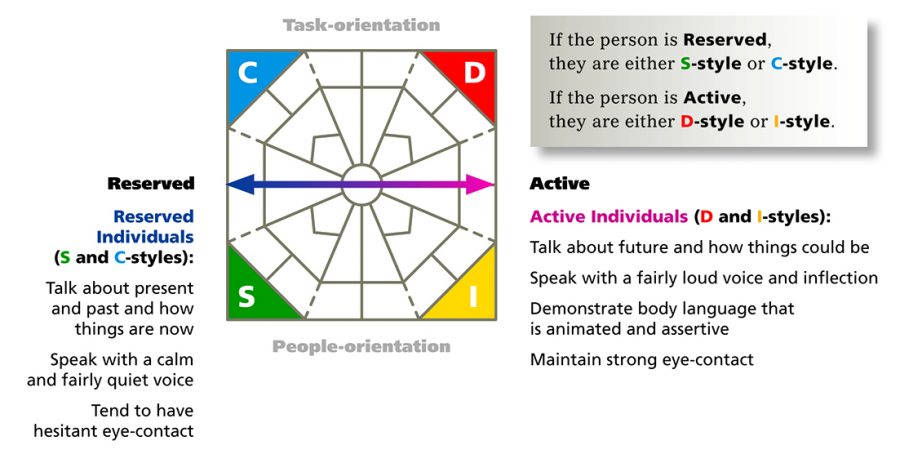 Once you’ve identified patterns of behaviors you ask yourself two basic assessment questions. First, determine if the person appears to be more Active or Reserved. Does the person tend to talk about future and how things could be? Are they more likely to talk about themselves as individuals? Is their body language more animated or assertive? Do they maintain strong eye contact? Do they speak with a louder voice and use lots of inflection. If so, they will more likely be on the Active half of the DISC Diamond, and therefore, either D-style or I-style.
Once you’ve identified patterns of behaviors you ask yourself two basic assessment questions. First, determine if the person appears to be more Active or Reserved. Does the person tend to talk about future and how things could be? Are they more likely to talk about themselves as individuals? Is their body language more animated or assertive? Do they maintain strong eye contact? Do they speak with a louder voice and use lots of inflection. If so, they will more likely be on the Active half of the DISC Diamond, and therefore, either D-style or I-style.
On the other hand, do they talk more about present and past and how things are now? Perhaps, they speak with a calm and fairly quiet voice. Is their body language more reserved and still? Do they tend to avoid eye contact? If so, the individual is like to be on the Reserved half of the DISC Diamond, and therefore, either S-style or C-style.
Step 2: A Stands for Assessing: People-Oriented or Task-Oriented?
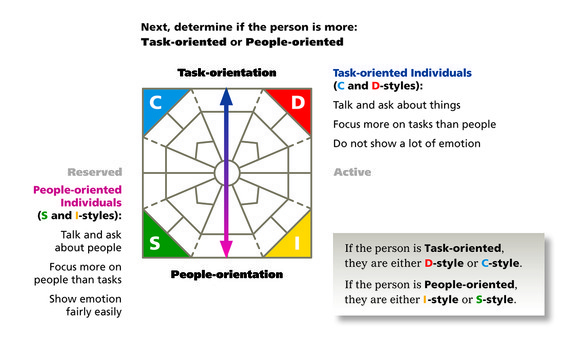 Now that you’ve identified Active or Reserved, you will need to determine if the person is more Task-oriented or People-oriented. Do they talk and ask more about things? Do they focus more on tasks than on feelings and people? Are they less emotional? If you’ve identified the person as Task-oriented, then they will be either D-style or C-style.
Now that you’ve identified Active or Reserved, you will need to determine if the person is more Task-oriented or People-oriented. Do they talk and ask more about things? Do they focus more on tasks than on feelings and people? Are they less emotional? If you’ve identified the person as Task-oriented, then they will be either D-style or C-style.
Let’s say the person talks and asks about people. They tend to focus more on people and emotions rather than tasks and things. You notice they show emotion fairly easily. If so, the person is more likely to be People-oriented, and therefore, either I-style or S-style.
Step 3: R Stands for Recognize
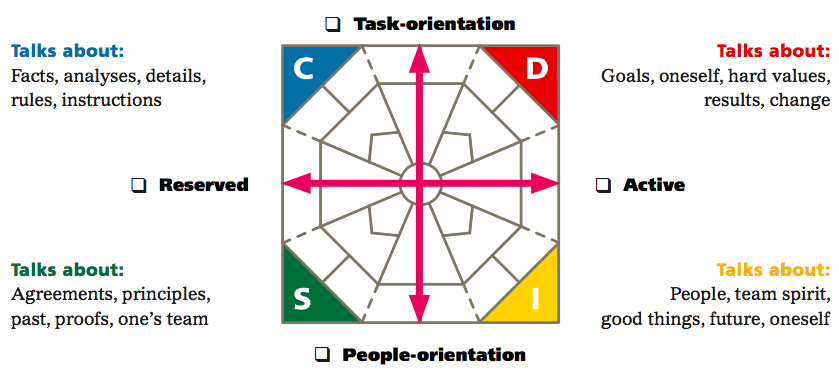 Now you have the information needed to recognize the person’s DISC style. You’ve used your observations to determine which 2 halves of the DISC Model the person is most likely to be on. By narrowing down the halves, you end up identifying the one DISC style the person is most likely to be.
Now you have the information needed to recognize the person’s DISC style. You’ve used your observations to determine which 2 halves of the DISC Model the person is most likely to be on. By narrowing down the halves, you end up identifying the one DISC style the person is most likely to be.
Try reading this exercise to recognize Vicky’s primary DISC style: “Vicky is a calm and logical person who does not like sudden changes. She tends to keep her opinions to herself and therefore, tends not to speak up. Vicky wants clear instructions and directions she can follow. She likes to work in a team and values a supervisor who is honest and trustworthy. Vicky is very loyal and conscientious when she’s treated fairly. She’s able to focus on small details and repeat tasks comfortably.” Did you identify Vicky as an S-style?
In summary, D-styles are Active and Task-focused, whereas, I-styles are Active and People-focused. S-styles are Reserved and People-focused, whereas, C-styles are Reserved and Task-focused. You will discover that observing behaviors becomes second nature and you will soon be doing it without thinking. The skill is part science, part art, and mostly PRACTICE. The bottom line is using DISC helps you communicate better with others.

